Cape to Cairo Journey:
Pages to Explore:
Blog Catagories:
Photo of the day








Home | About Us | Safaris & Photographic Trips | Blog | Contact Us | Sitemap | Disclaimer
The Essence of the Journey!
We would like to do this trip to experience new cultures.
We would like to understand what makes African people pure.
What are their spiritual beliefs, understandings?
How does the spiritual world we know exist to them?
What can we learn from them?

Timetravelling through Sudan
By: Celeste
┬Ā┬ĀLand of contrasts: dry and dusty ŌĆō green and fertile. The mud-brick architecture and way of life is unchanged through endless time. Unchanging too is the extreme heat and vastness of this desert land. Every kilometre is a step back in time as if the dominance of the Nile, the longest river in the world, is pitted against the might of the desert. A new understanding of the ŌĆ£sands of timeŌĆØ becomes apparent as we discover ancient sites ŌĆō themselves being rescued from or succumbing to these sands.
The Nubian Desert encroaches from our left, the Bayadu Desert from our right. We embrace our oasis, the Nubian Guesthouse in Karima, enclosing an in incredibly green lawn. The high-domed ceilings and shuttered rooms are quiet and dark wombs. Treated like royalty as the only guests, we are welcomed with traditional fresh juices: tabaldi (baobab) and karkaday (hibiscus).
After visiting the local police station to show our registration papers
┬Āfor this region, we approach the museum where staff and security police laze under the shade of an old and huge fruiting fig tree. Water is dripping from a tap, trickling into a mini Eden. The museum is small and dusty but worthwhile with a mummy still mysteriously giving off a scent. Death? What is death?
To the west is a small royal cemetery of about 20 pyramids. This was where Napatan kings were buried at the turn of the 3rd century BC. They are the most intact pyramids in Sudan, their lines silhouetted cleanly by their outer sandstone casings.
Across the Chinese bridge at Merowe, we wind our windows down to feel a part of the sultry breeze and friendliness. ┬ĀThe pyramids at Nuri are crumbing. Built in the early 7th century BC in the Nubian Dynasty as a royal cemetery, there are 19 royal tombs and 53 smaller queensŌĆÖ tombs. Sunset is peaceful and quiet as we marvel, our feet walking upon the sands of time.
A scorpion lies scorched in the ashtray as we exit the gate. The staff still lie sleeping out on their latticed beds in the courtyard. But Jebel Barkal, the holy mountain, awaits. It is believed to be the home of the god Amun, the ŌĆśThrone of Two LandsŌĆÖ ŌĆō Upper and Lower Egypt (Egypt and Nubia). The ŌĆśoldnessŌĆÖ is palpable in the dawn light. A serenity settles upon us as we view the Nile and its lush edges spread before us, the ruins of a massive temple, the Temple of Amun, at the foot of the mountain, at our feet.
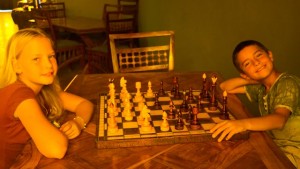 A sumptuous, fresh breakfast was followed by a game of chess for the kids (all templed out). I walked to the 150m Kushite Temple built by Thutmose III, Piye and Taharqa. Looking up at the pinnacle shaped like the ureaus ŌĆō the protective cobra and symbol of the king ŌĆō was humbling. Touching the columns, tracing the hieroglyphics with my fingertips, walking the smooth stone floors, a strange feeling overcomes me. More than the headiness of the heat and sweat, it is rather something just out of reach but a knowingness, too.
A sumptuous, fresh breakfast was followed by a game of chess for the kids (all templed out). I walked to the 150m Kushite Temple built by Thutmose III, Piye and Taharqa. Looking up at the pinnacle shaped like the ureaus ŌĆō the protective cobra and symbol of the king ŌĆō was humbling. Touching the columns, tracing the hieroglyphics with my fingertips, walking the smooth stone floors, a strange feeling overcomes me. More than the headiness of the heat and sweat, it is rather something just out of reach but a knowingness, too.
Bes, god of dancing, merriment and music, guardian of women in childbirth and Hathor, goddess of festivity, love, dance, the dead and the region of the dead, peer down from atop the columns of the Temple of Mut, the Egyptian sky goddess, bride of Amun. I enter into the mountain itself, into the sanctuary. The feeling intensifies. I stand still. The walls are covered by hieroglyphics and relief carvings, some still with their original colour. Astounding. A birthing chamber lies to the left where the royal wives came to make real the divinity of their lineage, each potential Pharaoh being the son of god, of course. To the right lies a chamber for the priests to receive, store and imbibe the offerings from the commoners. They were led to believe that the gods themselves partook of their offerings but being statues, how could they?
The rows of rams silently regarded me walking forward in time, back to Marcelo, Danica and Nicolai. I felt overwhelmed with love for my family ŌĆō as if I had been away from them for ever so long and I couldnŌĆÖt wait to see them again. Danica was writing in her diary; Marcelo was busy at his computer and Nicolai was helping the gardener. My preciouses!
Unmarked, I mean in English, the highway takes us ESE to Atbara and then SSW towards Meroe. A South African registered 4×4 almost gets a hug from us as it sat waiting for its owners outside the Pyramids of Meroe. Instead we left our card on the windscreen to say ŌĆśhiŌĆÖ. Knowing they would camp out under the stars gave us a twang of disappointment that we had not brought our trailer this far.
Seeing these magnificent structures, the children could not believe they had been decapitated in 1834 by a greedy treasure hunter. Some of the funerary temples have been restored and there is a wonderful sense of companionship amongst these pyramids.
The children go on a camel ride, Nicolai giving a little yell as his beast lurches from a seated to an upright, standing position. How they sit with their ankles and knees as sharply folded as they do amazes me and I know it did Lyall Watson too as he has written on just this topic. About 100 pyramids commemorate and guard the dead kings, queens and nobles of the Kushite era. And we thought Egypt was the only place with pyramids!
The morning is bright and clear in semi-desert scrubland with small herds of thin cattle,
donkeys and woolly, fat- and long-tailed sheep. ŌĆ£Thirty-five kilometers of tracks off-road to see more temples,ŌĆØ says Nicolai disdainfully. Promises of tea and a snack ease him somewhat. Naqa is the place of the Temple dedicated to Amun erected in the 1st century AD by King Natakam of Kush. It is laid out according to the typical Egyptian floorplan with an avenue of rams, an outer court, a colonnade approaching a hypostyle hall and an inner sanctuary chamber.
The Lion Temple is beautifully preserved with clear reliefs of the lion-headed Kushite god Apedemak and his wife Amanitore. They stand triumphant over their vanquished prisoners. He is also represented with a snakeŌĆÖs body emerging from a lotus flower. The art and representations in the temple and the kiosk alongside have been influenced by Greek, Roman and Persian flavours.  The nearby well and waterhole is visited by a nomad and his three girls on donkeyback. We eye each other out, gesturing and smiling in a friendly manner. We come in peace. A meeting of travelers from lands far away and a nomadic tribesman that could speak of time gone by ŌĆō even to that of the building of these temples. Who or what or what pantheon of gods are his now, I wonder.
The nearby well and waterhole is visited by a nomad and his three girls on donkeyback. We eye each other out, gesturing and smiling in a friendly manner. We come in peace. A meeting of travelers from lands far away and a nomadic tribesman that could speak of time gone by ŌĆō even to that of the building of these temples. Who or what or what pantheon of gods are his now, I wonder.
Khartoum welcomes us back again. At Al Mogran, the confluence of the Blue and White
Niles, it feels somewhat like home where we, too, live on the confluence of two rivers. Moving in so southerly a direction feels strange after nearly 11 months of a more-or-less northerly bearing. The past and future seemingly blend into the present.




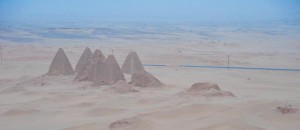

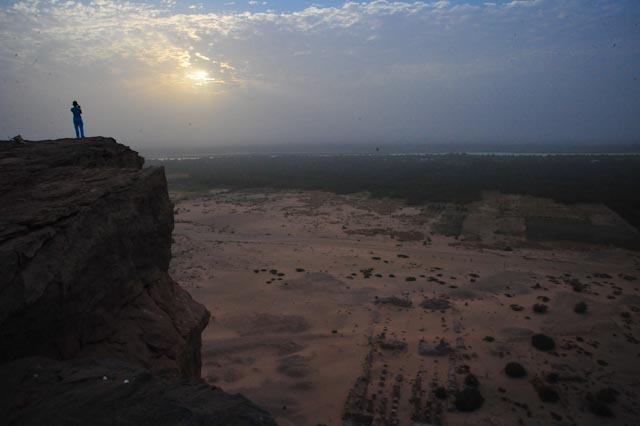


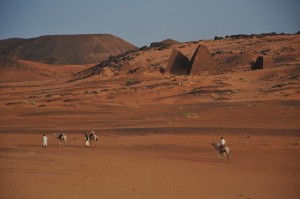
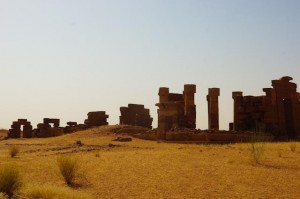



I loved egypt. It just offered such different sites, something that is totally foreign to us. It looks like you are getting the real nomad look.
Ps. Make sure that you are backing up your photos. I lost 80percent of mine
You’ll just have to do the trip again …
Cel, I am really glad you enjoyed Sudan! And I am still jealous. Just been back to SA for the conference in sun city. it was survivable. At least got 2 hrs in the pilansberg, so keeps the appetite going. We have decided it’s time to start exploring west africa. So, Gambia in Feb. Thought we’d start with an easier one, plus, you never know, safety flips like a coin….enjoy the last leg! Off to Rome tomorrow. Must say I am really excited about that. We are taking some days off after the meeting and I am hoping my 5 years of Latin will come back like a flash!
Celeste and clan, amazing!
Can you guys believe that you are almost at the chequered flag.
A lifetime of memories in 1 year. You guys have really done well and I salute your tenacity and ultimately the cause you are supporting. Just to let you know that all the Mercedes Historic Racing cars ran with the “Red Horn” onour vehicles for Rhino Day 2 weeks back at Zwartkops. Really looked cool and I sincerely hope that a whole lot of little efforts amount to a huge mind shift.
I am really glad that your experiences in Sudan, despite on-going negativity about the country / countries, was positive and that peoples kindness transcends all geo-political issues.
I must however ask you a question as I read your articles and somehow must have missed something about your trailer? I see all your photos without it? Did I miss something???
Awiating your reply and wish you a spectacular last push northwards.Insh’Allah.
Mike, Iva & the Girls